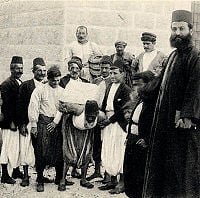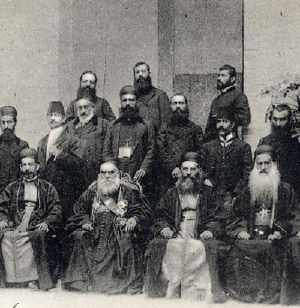Maronite Church
Maronites (Arabic: الموارنة, transliteration: Mawārinah, Syriac: ܡܪܘܢܝܐ, Latin: Ecclesia Maronitarum) are members of one of the Syriac Eastern Catholic Churches, with a heritage reaching back to Maron in the early 5th century. The first Maronite patriarch, John Maron, was appointed in the late 7th century. Although reduced in numbers and estimated to have lost their status as a majority in Lebanon itself, today, Maronites remain one of the principal religious groups in the country.
Before the conquest by Arabian Muslims reached Lebanon, which resulted in the Arabization of both those who would become Islamized and those that would remain non-Islamized, the Lebanese people, including Maronites, spoke a dialect of Aramaic,[1] but have been Arabic-speaking since at least the 15th century.[2][3] Syriac however, still remains the liturgical language of the Maronite Church.Cite error: Closing </ref> missing for <ref> tag It is estimated that 1,000,000 to 1,500,000 remain in Lebanon where they constitute up to 25% of the population. According to a Lebanese agreement celebrated among the various religious leaders, the president must be a Maronite. Syrian Maronites total 40,000 and they follow the archdioceses of Aleppo and Damascus and the Diocese of Latakia. There is also a Maronite community in Cyprus which speaks Cypriot Maronite Arabic,[4] They are a recognized religious minority on the island and the community elects a representative to sit in the house of representatives (parliament) to voice their interests. They are probably descended from those Maronites who accompanied the crusaders there. A noticeable Maronite community also exists in northern Israel.
The two residing eparchies in the United States have issued their own "Maronite Census." The Census is designed to estimate approximately how many Maronites reside in the United States due to their emigrations to that country. Many Maronites have been assimilated into American culture, often taking on Roman Catholicism as there were no Maronite parishes or priests available. The Census was designed to locate those people. There is also an eparchy in São Paulo, Brazil.
Modern Maronites, like other Christians in the Levant, often adopt French or other Western European given names (with biblical origins) for their children like "Michel," "Marc," "Marie," "Georges," "Carole," "Charles," "Chris," "Antoine," and "Pierre."
Given names of Arabic origins identical with those of their Muslim neighbors are also common, such as "Khalil," "Samir," "Salim," "Jameel," or "Tawfik." Other common names are strictly Christian and are Aramaic, or Arabic, forms of biblical, Hebrew, or Greek Christian names, such as "Antun," (Anthony, also "Tanios," "Antonios," or "Tannous"), "Butros" (Peter), "Boulos (Paul)," "Semaan" or "Shamaoun" (Simon), "Jergyes" (George), "Elie" (Ilyas, or Elias), "Iskander" (Alexander), or "Beshara" (literally, "Good News" in reference to the Gospel), other common names are Sarkis (Sergius) and Bakhos (Bacchus), while others are common both among Christians and Muslims, such as "Yousseff" (Joseph) or "Ibrahim" (Abraham).
Some Maronite Christians are named in honour of Maronite saints, including the Aramaic names "Maroun" (after their patron saint, Maron), "Sharbel" or "Charbel," or "Rafqa"
ReferencesISBN links support NWE through referral fees
- ↑ Review of Phares Boo Retrieved June 25, 2008.
- ↑ The Precarious Republic: Political Modernization in Lebanon By Michael C. Hudson, 1968
- ↑ Lebanon: Its Stand in History Among the Near East Countries By Salim Wakim, 1996.
- ↑ [1] A descriptive analysis of Cypriot Maronite Arabic by Maria Tsiapera
Books
- Kamal Salibi - A House of Many Mansions - The History of Lebanon Reconsidered (University of California Press, 1990).
- Father AJ Salim - Captivated by Your Teachings - A Resource Book for Adult Maronite Catholics (ET Nedder Publishing, Tucson, Arizona, 2002)
- Maronite Church. New Catholic Encyclopedia, Second Edition, 2003.
- Riley-Smith, Johnathan - The Oxford Illustrated History of the Crusades (Oxford University Press, Oxford, 1995)
- Soffee, Anne Thomas - Snake Hips: Belly Dancing and How I Found True Love (Chicago Review Press, Chicago, 2002)
Credits
New World Encyclopedia writers and editors rewrote and completed the Wikipedia article in accordance with New World Encyclopedia standards. This article abides by terms of the Creative Commons CC-by-sa 3.0 License (CC-by-sa), which may be used and disseminated with proper attribution. Credit is due under the terms of this license that can reference both the New World Encyclopedia contributors and the selfless volunteer contributors of the Wikimedia Foundation. To cite this article click here for a list of acceptable citing formats.The history of earlier contributions by wikipedians is accessible to researchers here:
The history of this article since it was imported to New World Encyclopedia:
Note: Some restrictions may apply to use of individual images which are separately licensed.

